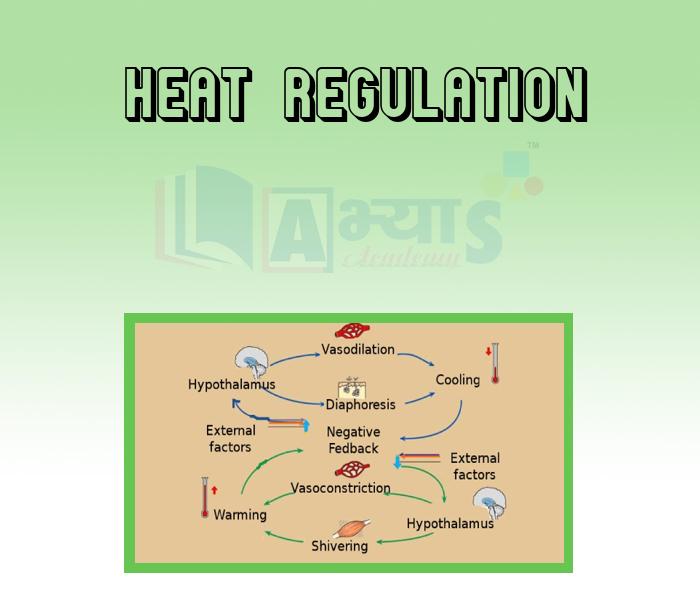Heat Regulation

Heat Regulation
Animals can be divided into two categories based on there methods of heat regulation or thermo regulation. They can be ectothermic or endothermic
Ectothermic : This category include animals whose regulation of body temperature depends on external sources. They cannot maintain there own body temperature. The ectotherms include the fishes, amphibians, reptiles and invertebrates. These are also called as cold blooded animals
Endothermic : Endotherms use internally generated heat to maintain body temperature. Their body temperature tends to stay steady regardless of environment. Eg : Birds and mammals. These are also known as warm blooded animals.
These two categories of animals show different adaptations to regulate there body temperature. Movement of blood vessels also help in regulation of heat in the body. As these vessels carry blood therefore, there movements results in change in the temperature of whole body.
Vasodilation : Vasodilation is the widening of your vessels. It happens when smooth muscles found in the walls of arteries or large veins relax, allowing the blood vessels to become more open. This result in increase in the blood flow through vessels as well as decrease in blood pressure. This increased blood flow increases the loss of heat from the body. Vasodilation usually occur in the vessels attached to the skin during summer season.
Vasoconstriction : Vasoconstriction is the narrowing of blood vessels that results from the constriction of muscles of the blood vessels. Constriction of blood vessels results in decreased blood flow and increased blood pressure. Due to less flow of blood there occur less loss of heat from the body. So, vasoconstriction is usually occur in winter season or at low temperature. The blood vessels of skin constrict to reduce heat loss of the body.
In this way different movements of blood vessels results in heat regulation in different organisms.
Students / Parents Reviews [10]
Abhyas is a complete education Institute. Here extreme care is taken by teacher with the help of regular exam. Extra classes also conducted by the institute, if the student is weak.

Om Umang
10thBeing a parent, I saw my daughter improvement in her studies by seeing a good result in all day to day compititive exam TMO, NSO, IEO etc and as well as studies. I have got a fruitful result from my daughter.

Prisha Gupta
8thOne of the best institutes to develope a child interest in studies.Provides SST and English knowledge also unlike other institutes. Teachers are co operative and friendly online tests andPPT develope practical knowledge also.

Aman Kumar Shrivastava
10thIt was a good experience with Abhyas Academy. I even faced problems in starting but slowly and steadily overcomed. Especially reasoning classes helped me a lot.

Cheshta
10thAbhyas Methodology is very good. It is based on according to student and each child manages accordingly to its properly. Methodology has improved the abilities of students to shine them in future.

Manish Kumar
10thIt was good as the experience because as we had come here we had been improved in a such envirnment created here.Extra is taught which is beneficial for future.

Eshan Arora
8thMy experience with Abhyas is very good. I have learnt many things here like vedic maths and reasoning also. Teachers here first take our doubts and then there are assignments to verify our weak points.

Shivam Rana
7thA marvelous experience with Abhyas. I am glad to share that my ward has achieved more than enough at the Ambala ABHYAS centre. Years have passed on and more and more he has gained. May the centre flourish and develop day by day by the grace of God.

Archit Segal
7thAbout Abhyas metholodology the teachers are very nice and hardworking toward students.The Centre Head Mrs Anu Sethi is also a brilliant teacher.Abhyas has taught me how to overcome problems and has always taken my doubts and suppoeted me.

Shreya Shrivastava
8thMy experience with Abhyas academy is very good. I did not think that my every subject coming here will be so strong. The main thing is that the online tests had made me learn here more things.

